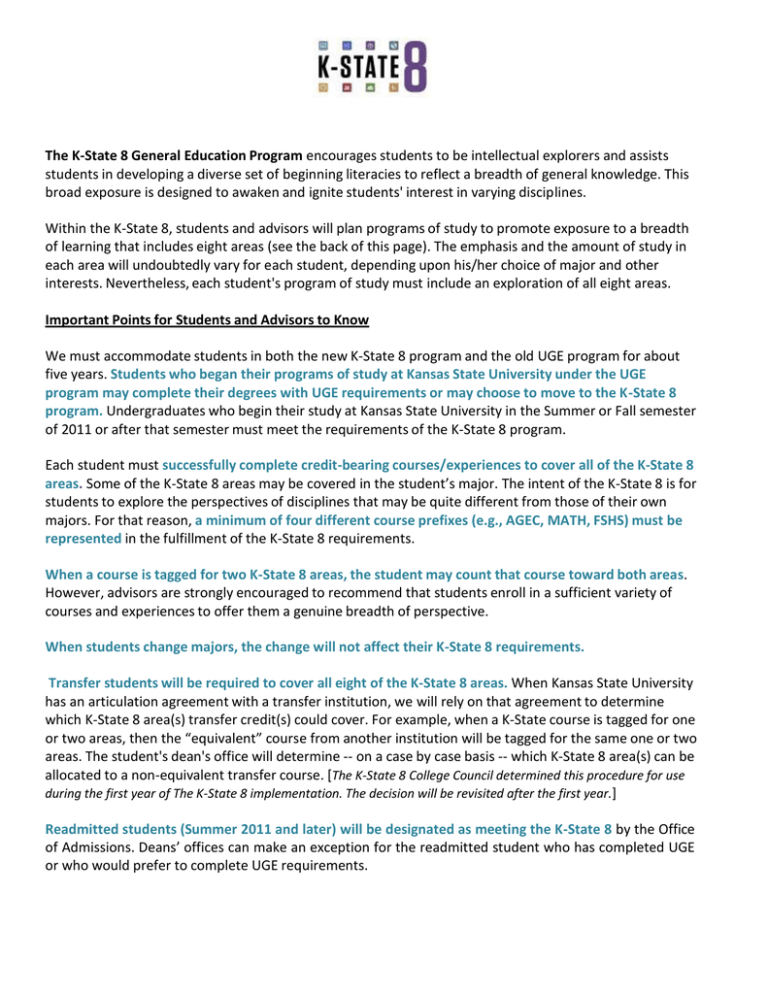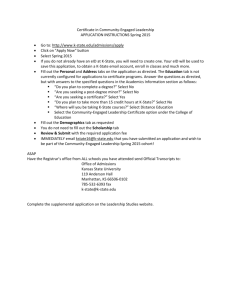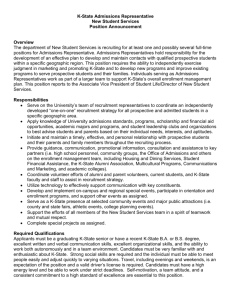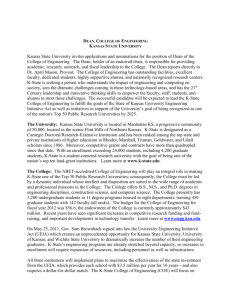Document 12957511
advertisement

The K-State 8 General Education Program encourages students to be intellectual explorers and assists students in developing a diverse set of beginning literacies to reflect a breadth of general knowledge. This broad exposure is designed to awaken and ignite students' interest in varying disciplines. Within the K-State 8, students and advisors will plan programs of study to promote exposure to a breadth of learning that includes eight areas (see the back of this page). The emphasis and the amount of study in each area will undoubtedly vary for each student, depending upon his/her choice of major and other interests. Nevertheless, each student's program of study must include an exploration of all eight areas. Important Points for Students and Advisors to Know We must accommodate students in both the new K-State 8 program and the old UGE program for about five years. Students who began their programs of study at Kansas State University under the UGE program may complete their degrees with UGE requirements or may choose to move to the K-State 8 program. Undergraduates who begin their study at Kansas State University in the Summer or Fall semester of 2011 or after that semester must meet the requirements of the K-State 8 program. Each student must successfully complete credit-bearing courses/experiences to cover all of the K-State 8 areas. Some of the K-State 8 areas may be covered in the student’s major. The intent of the K-State 8 is for students to explore the perspectives of disciplines that may be quite different from those of their own majors. For that reason, a minimum of four different course prefixes (e.g., AGEC, MATH, FSHS) must be represented in the fulfillment of the K-State 8 requirements. When a course is tagged for two K-State 8 areas, the student may count that course toward both areas. However, advisors are strongly encouraged to recommend that students enroll in a sufficient variety of courses and experiences to offer them a genuine breadth of perspective. When students change majors, the change will not affect their K-State 8 requirements. Transfer students will be required to cover all eight of the K-State 8 areas. When Kansas State University has an articulation agreement with a transfer institution, we will rely on that agreement to determine which K-State 8 area(s) transfer credit(s) could cover. For example, when a K-State course is tagged for one or two areas, then the “equivalent” course from another institution will be tagged for the same one or two areas. The student's dean's office will determine -- on a case by case basis -- which K-State 8 area(s) can be allocated to a non-equivalent transfer course. [The K-State 8 College Council determined this procedure for use during the first year of The K-State 8 implementation. The decision will be revisited after the first year.] Readmitted students (Summer 2011 and later) will be designated as meeting the K-State 8 by the Office of Admissions. Deans’ offices can make an exception for the readmitted student who has completed UGE or who would prefer to complete UGE requirements. K-State 8 Areas – Stated as Learning Goals The more complete descriptions as included in the original proposal will be available on the website for The K-State 8. Aesthetic Experience and Interpretive Understanding. Students will develop interpretive skills and heighten aesthetic responses to literature, the performing arts, and the visual arts. Empirical and Quantitative Reasoning. Students will gather and evaluate information, weigh alternative evidence, understand the likelihood of particular outcomes, and recognize when available evidence is inadequate to draw a conclusion. Ethical Reasoning and Responsibility. Students will think through ethical dilemmas, make sound decisions when facing real-life situations, and apply ethical standards to social and environmental issues. Global Issues and Perspectives. Students will be aware of values, perspectives, beliefs, behaviors, policies and customs from around the world by exploring the interdependence of people, nations and systems across the globe. Historical Perspectives. Students will realize the need to understand the past and thoughtfully consider the future to contextualize current knowledge, to glimpse how it may continue to develop and to examine the roles they might play. Human Diversity within the U.S. Students will develop an awareness of self and multiple perspectives about U.S. society and how group affiliation affects people's perceptions and experiences. Natural and Physical Sciences. Students will use central facts, ideas and theories related to the study of living systems and the physical universe to evaluate the merit of scientific and technological claims. Social Sciences. Students will understand how individuals, families, groups, institutions, governments and societies behave and influence one another and the natural environment; and analyze and understand interactions of various social factors that influence behavior at these multiple levels. Icons for the K-State 8 areas are used in iSIS and the course schedule but not in DARS or the electronic catalog.






